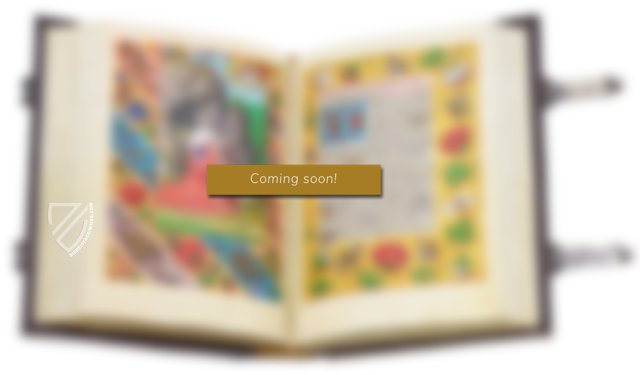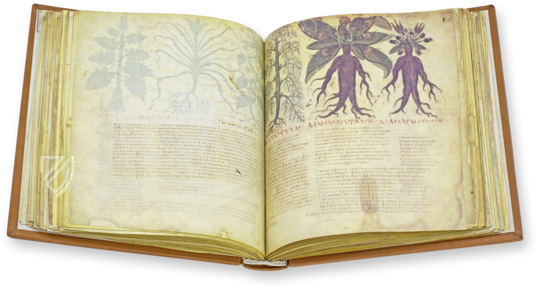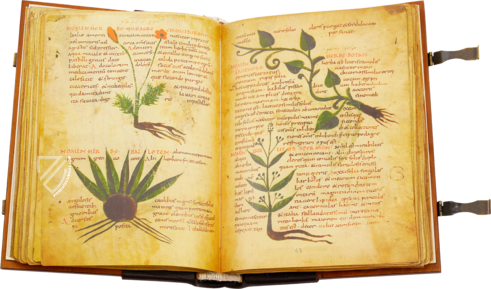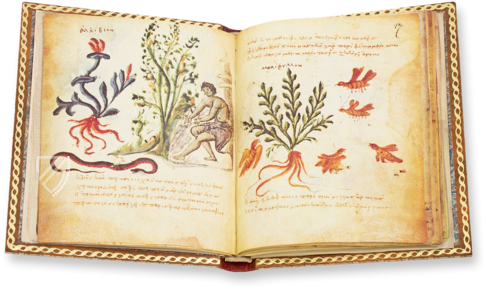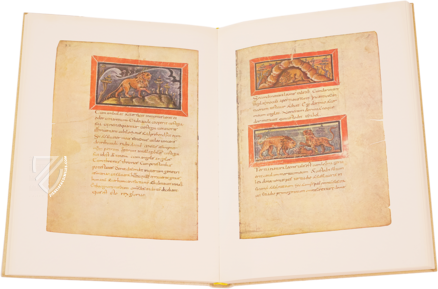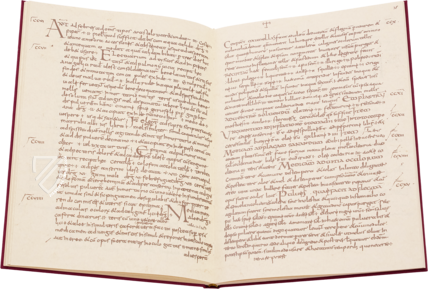Bald’s Leechbook
(under 1,000€)
Bald’s Leechbook is a large Old English collection of medical remedies ranging from Late Antiquity to contemporary Anglo-Saxon sources. This important work survives in only one manuscript and its name is a modernization of the Old English lǣce-bōc or “book of medical prescriptions” in combination with the name of the man who patronized the manuscript. The text was created in the 9th century, possibly as part of the educational reforms of King Alfred the Great, and the manuscript itself originates from the mid-10th century. The work is organized from head-to-foot: the first book covers external maladies, the second internal disorders, and the third is a text comprising Anglo-Saxon medical practices predating the influences of Mediterranean sources. Recent research indicates that one of the remedies found in the manuscript, known as “Bald’s eyesalve”, has promise as a treatment for the antibiotic-resistant MRSA virus.
Bald’s Leechbook
Also known as Medicinale Anglicum from an inscription in the binding, Bald’s Leechbook is a large Old English manuscript consisting of medical remedies, diagnoses, charms, and a prognostic text about the dog days of summer. Despite the common misconception that its title is a reference to the use of leeches, the word in this context actually comes from læca, the Old English word for “physician”, thus it is a doctor’s handbook.
Most of its recipes are drawn from the medical traditions of the ancient Greeks and Romans but one text, known as Leechbook III reflects the treatments of the Anglo-Saxons without Mediterranean influences. This splendid compilation thus represents a physician’s attempt at blending the best parts of both traditions. It is a true unicum, the only surviving manuscript to contain these texts.
A Latin inscription in the colophon at the end of the second book both identifies the original patron and also testifies that this was already a precious and coveted codex a thousand years ago: “Bald owns this book, which he ordered Cild to write … Nothing is as dear to me as this treasure.”
A Unique Medical Manuscript
Aside from being the only extant example of the text, Bald’s Leechbook is probably the only medieval medical text to separate external maladies from internal disorders **, which are addressed in the first book and second book, respectively. Both have a table of contents and are organized beginning with the head and finishing with the feet. The text also includes **the only Anglo-Saxon manual on plastic surgery, specifically a prescription for treating a cleft lip and palate. Miscellaneous medical information that caught the eye of the scribe was recorded in the Lacnunga, a commonplace book.
Remedies from Jerusalem for the King of England
One passage contains an Old English translation of various remedies sent by Patriarch Elias III of Jerusalem (r. ca. 879–907) to treat the chronic, debilitating illness that afflicted King Alfred the Great (848/849–899), most likely Chron’s disease or hemorrhoids. It is thus a rare example of the specific treatment given to an early medieval monarch, and an example of deferring to a respected medical authority on the other side of Christendom who would doubtless have ample access to Arab medicine. Aside from treating diseases of the body, the text also addresses ailments of the soul including a salve that is prescribed against elves, night goblins, and devils.
Medical Treatment during the Dog Days of Summer
Since ancient times, the hottest and most uncomfortable part of summer has been referred to as the dog days because of its association with Sirius, colloquially known as the “Dog Star”. Hellenistic astrology made the connection between Sirius and the perceived increase in heat, drought, sudden crop-ruining thunderstorms, lethargy, fever, mad dog attacks, and bad luck in general. The Romans carried on this tradition and transmitted it to medieval and early modern Europeans who believed that bloodletting should be avoided during this time because men are in a weakened state from the heat. Furthermore, abstaining from overeating and the temptations of women was also recommended. Even after the connection between medicine and astrology was severed, the negative effects of particularly hot weather remain very real, and doctors continue to notice a connection between this one to two month period of time and e.g. an increased risk of infection after surgery.
A Thousand-Year-Old Medical Breakthrough
The text includes various treatments for conditions ranging from headaches, circulatory problems, and male impotence to shingles, aching feet, and an infected sty. The last treatment, known as Bald’s eyesalve, includes garlic, leeks, wine, and bovine bile left in a brass bowl for nine days that made headlines in 2015 when it was revealed to have bactericidal effects against the dreaded, antibiotic-resistant MRSA bacteria, which has killed hundreds of thousands of people. Its potential medical applications are still being researched and while Bald’s Leechbook may be unique among medieval medical texts for still being used by modern medicine for now, it has certainly unleashed a new wave of interest in the potential uses of the often maligned and misunderstood medicine of the Middle Ages.
Codicology
- Alternative Titles
- Balds Arzneibuch
Bald's Laeceboc - Size / Format
- 256 pages / 27.0 × 19.0 cm
- Origin
- United Kingdom
- Date
- Mid 10th century
- Epochs
- Style
- Language
#1 Bald’s Leechbook
(under 1,000€)
- Treatises / Secular Books
- Apocalypses / Beatus
- Astronomy / Astrology
- Bestiaries
- Bibles / Gospels
- Chronicles / History / Law
- Geography / Maps
- Saints' Lives
- Islam / Oriental
- Judaism / Hebrew
- Single Leaf Collections
- Leonardo da Vinci
- Literature / Poetry
- Liturgical Manuscripts
- Medicine / Botany / Alchemy
- Music
- Mythology / Prophecies
- Psalters
- Other Religious Books
- Games / Hunting
- Private Devotion Books
- Other Genres
- Afghanistan
- Armenia
- Austria
- Belgium
- Belize
- Bosnia and Herzegovina
- China
- Colombia
- Costa Rica
- Croatia
- Cyprus
- Czech Republic
- Denmark
- Egypt
- El Salvador
- Ethiopia
- France
- Germany
- Greece
- Guatemala
- Honduras
- Hungary
- India
- Iran
- Iraq
- Israel
- Italy
- Japan
- Jordan
- Kazakhstan
- Kyrgyzstan
- Lebanon
- Liechtenstein
- Luxembourg
- Mexico
- Morocco
- Netherlands
- Palestine
- Panama
- Peru
- Poland
- Portugal
- Romania
- Russia
- Serbia
- Spain
- Sri Lanka
- Sweden
- Switzerland
- Syria
- Tajikistan
- Turkey
- Turkmenistan
- Ukraine
- United Kingdom
- United States
- Uzbekistan
- Vatican City
- A. Oosthoek, van Holkema & Warendorf
- Aboca Museum
- Ajuntament de Valencia
- Akademie Verlag
- Akademische Druck- u. Verlagsanstalt (ADEVA)
- Aldo Ausilio Editore - Bottega d’Erasmo
- Alecto Historical Editions
- Alkuin Verlag
- Almqvist & Wiksell
- Amilcare Pizzi
- Andreas & Andreas Verlagsbuchhandlung
- Archa 90
- Archiv Verlag
- Archivi Edizioni
- Arnold Verlag
- ARS
- Ars Magna
- ArtCodex
- AyN Ediciones
- Azimuth Editions
- Badenia Verlag
- Bärenreiter-Verlag
- Belser Verlag
- Belser Verlag / WK Wertkontor
- Benziger Verlag
- Bernardinum Wydawnictwo
- BiblioGemma
- Biblioteca Apostolica Vaticana (Vaticanstadt, Vaticanstadt)
- Bibliotheca Palatina Faksimile Verlag
- Bibliotheca Rara
- Boydell & Brewer
- Bramante Edizioni
- Bredius Genootschap
- Brepols Publishers
- British Library
- C. Weckesser
- Caixa Catalunya
- Canesi
- CAPSA, Ars Scriptoria
- Caratzas Brothers, Publishers
- Carus Verlag
- Casamassima Libri
- Centrum Cartographie Verlag GmbH
- Chavane Verlag
- Christian Brandstätter Verlag
- Circulo Cientifico
- Club Bibliófilo Versol
- Club du Livre
- CM Editores
- Collegium Graphicum
- Collezione Apocrifa Da Vinci
- Comissão Nacional para as Comemorações dos Descobrimentos Portugueses
- Coron Verlag
- Corvina
- CTHS
- D. S. Brewer
- Damon
- De Agostini/UTET
- De Nederlandsche Boekhandel
- De Schutter
- Deuschle & Stemmle
- Deutscher Verlag für Kunstwissenschaft
- DIAMM
- Droz
- E. Schreiber Graphische Kunstanstalten
- Ediciones Boreal
- Ediciones Grial
- Ediclube
- Edições Inapa
- Edilan
- Editalia
- Edition Deuschle
- Edition Georg Popp
- Edition Leipzig
- Edition Libri Illustri
- Editiones Reales Sitios S. L.
- Éditions de l'Oiseau Lyre
- Editions Medicina Rara
- Editorial Casariego
- Editorial Mintzoa
- Editrice Antenore
- Editrice Velar
- Edizioni Edison
- Egeria, S.L.
- Eikon Editores
- Electa
- Emery Walker Limited
- Enciclopèdia Catalana
- Eos-Verlag
- Ephesus Publishing
- Ernst Battenberg
- Eugrammia Press
- Extraordinary Editions
- Fackelverlag
- Facsimila Art & Edition
- Facsimile Editions Ltd.
- Facsimilia Art & Edition Ebert KG
- Faksimile Verlag
- Feuermann Verlag
- Folger Shakespeare Library
- Franco Cosimo Panini Editore
- Friedrich Wittig Verlag
- Fundación Hullera Vasco-Leonesa
- G. Braziller
- Gabriele Mazzotta Editore
- Gebr. Mann Verlag
- Gesellschaft für graphische Industrie
- Getty Research Institute
- Giovanni Domenico de Rossi
- Giunti Editore
- Graffiti
- Grafica European Center of Fine Arts
- Guido Pressler
- Guillermo Blazquez
- Gustav Kiepenheuer
- H. N. Abrams
- Harrassowitz
- Harvard University Press
- Helikon
- Hendrickson Publishers
- Henning Oppermann
- Herder Verlag
- Hes & De Graaf Publishers
- Hoepli
- Holbein-Verlag
- Houghton Library
- Hugo Schmidt Verlag
- Idion Verlag
- Il Bulino, edizioni d'arte
- ILte
- Imago
- Insel Verlag
- Insel-Verlag Anton Kippenberger
- Instituto de Estudios Altoaragoneses
- Instituto Nacional de Antropología e Historia
- Introligatornia Budnik Jerzy
- Istituto dell'Enciclopedia Italiana - Treccani
- Istituto Ellenico di Studi Bizantini e Postbizantini
- Istituto Geografico De Agostini
- Istituto Poligrafico e Zecca dello Stato
- Italarte Art Establishments
- Jan Thorbecke Verlag
- Johnson Reprint Corporation
- Josef Stocker
- Josef Stocker-Schmid
- Jugoslavija
- Karl W. Hiersemann
- Kasper Straube
- Kaydeda Ediciones
- Kindler Verlag / Coron Verlag
- Kodansha International Ltd.
- Konrad Kölbl Verlag
- Kurt Wolff Verlag
- La Liberia dello Stato
- La Linea Editrice
- La Meta Editore
- Lambert Schneider
- Landeskreditbank Baden-Württemberg
- Leo S. Olschki
- Les Incunables
- Liber Artis
- Library of Congress
- Libreria Musicale Italiana
- Lichtdruck
- Lito Immagine Editore
- Lumen Artis
- Lund Humphries
- M. Moleiro Editor
- Maison des Sciences de l'homme et de la société de Poitiers
- Manuscriptum
- Martinus Nijhoff
- Maruzen-Yushodo Co. Ltd.
- MASA
- Massada Publishers
- McGraw-Hill
- Metropolitan Museum of Art
- Militos
- Millennium Liber
- Müller & Schindler
- Nahar - Stavit
- Nahar and Steimatzky
- National Library of Wales
- Neri Pozza
- Nova Charta
- Oceanum Verlag
- Odeon
- Orbis Mediaevalis
- Orbis Pictus
- Österreichische Staatsdruckerei
- Oxford University Press
- Pageant Books
- Parzellers Buchverlag
- Patrimonio Ediciones
- Pattloch Verlag
- PIAF
- Pieper Verlag
- Plon-Nourrit et cie
- Poligrafiche Bolis
- Presses Universitaires de Strasbourg
- Prestel Verlag
- Princeton University Press
- Prisma Verlag
- Priuli & Verlucca, editori
- Pro Sport Verlag
- Propyläen Verlag
- Pytheas Books
- Quaternio Verlag Luzern
- Reales Sitios
- Recht-Verlag
- Reichert Verlag
- Reichsdruckerei
- Reprint Verlag
- Riehn & Reusch
- Roberto Vattori Editore
- Rosenkilde and Bagger
- Roxburghe Club
- Salerno Editrice
- Saltellus Press
- Sandoz
- Sarajevo Svjetlost
- Schöck ArtPrint Kft.
- Schulsinger Brothers
- Scolar Press
- Scrinium
- Scripta Maneant
- Scriptorium
- Shazar
- Siloé, arte y bibliofilia
- SISMEL - Edizioni del Galluzzo
- Sociedad Mexicana de Antropología
- Société des Bibliophiles & Iconophiles de Belgique
- Soncin Publishing
- Sorli Ediciones
- Stainer and Bell
- Studer
- Styria Verlag
- Sumptibus Pragopress
- Szegedi Tudomànyegyetem
- Taberna Libraria
- Tarshish Books
- Taschen
- Tempus Libri
- Testimonio Compañía Editorial
- Thames and Hudson
- The Clear Vue Publishing Partnership Limited
- The Facsimile Codex
- The Folio Society
- The Marquess of Normanby
- The Richard III and Yorkist History Trust
- Tip.Le.Co
- TouchArt
- TREC Publishing House
- TRI Publishing Co.
- Trident Editore
- Tuliba Collection
- Typis Regiae Officinae Polygraphicae
- Union Verlag Berlin
- Universidad de Granada
- University of California Press
- University of Chicago Press
- Urs Graf
- Vallecchi
- Van Wijnen
- VCH, Acta Humaniora
- VDI Verlag
- VEB Deutscher Verlag für Musik
- Verlag Anton Pustet / Andreas Verlag
- Verlag Bibliophile Drucke Josef Stocker
- Verlag der Münchner Drucke
- Verlag für Regionalgeschichte
- Verlag Styria
- Vicent Garcia Editores
- W. Turnowski Ltd.
- W. Turnowsky
- Waanders Printers
- Wiener Mechitharisten-Congregation (Wien, Österreich)
- Wissenschaftliche Buchgesellschaft
- Wissenschaftliche Verlagsgesellschaft
- Wydawnictwo Dolnoslaskie
- Xuntanza Editorial
- Zakład Narodowy
- Zollikofer AG


